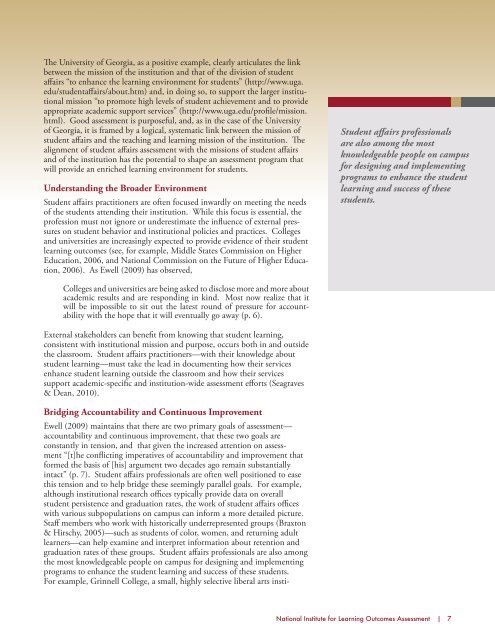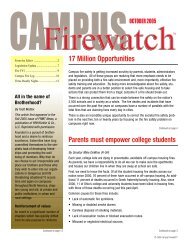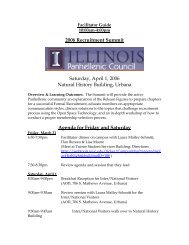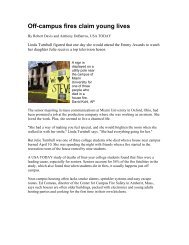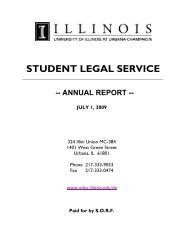StudentAffairsRole in Assessment - Office of the Dean of Students ...
StudentAffairsRole in Assessment - Office of the Dean of Students ...
StudentAffairsRole in Assessment - Office of the Dean of Students ...
You also want an ePaper? Increase the reach of your titles
YUMPU automatically turns print PDFs into web optimized ePapers that Google loves.
The University <strong>of</strong> Georgia, as a positive example, clearly articulates <strong>the</strong> l<strong>in</strong>k<br />
between <strong>the</strong> mission <strong>of</strong> <strong>the</strong> <strong>in</strong>stitution and that <strong>of</strong> <strong>the</strong> division <strong>of</strong> student<br />
affairs “to enhance <strong>the</strong> learn<strong>in</strong>g environment for students” (http://www.uga.<br />
edu/studentaffairs/about.htm) and, <strong>in</strong> do<strong>in</strong>g so, to support <strong>the</strong> larger <strong>in</strong>stitutional<br />
mission “to promote high levels <strong>of</strong> student achievement and to provide<br />
appropriate academic support services” (http://www.uga.edu/pr<strong>of</strong>ile/mission.<br />
html). Good assessment is purposeful, and, as <strong>in</strong> <strong>the</strong> case <strong>of</strong> <strong>the</strong> University<br />
<strong>of</strong> Georgia, it is framed by a logical, systematic l<strong>in</strong>k between <strong>the</strong> mission <strong>of</strong><br />
student affairs and <strong>the</strong> teach<strong>in</strong>g and learn<strong>in</strong>g mission <strong>of</strong> <strong>the</strong> <strong>in</strong>stitution. The<br />
alignment <strong>of</strong> student affairs assessment with <strong>the</strong> missions <strong>of</strong> student affairs<br />
and <strong>of</strong> <strong>the</strong> <strong>in</strong>stitution has <strong>the</strong> potential to shape an assessment program that<br />
will provide an enriched learn<strong>in</strong>g environment for students.<br />
Understand<strong>in</strong>g <strong>the</strong> Broader Environment<br />
Student affairs practitioners are <strong>of</strong>ten focused <strong>in</strong>wardly on meet<strong>in</strong>g <strong>the</strong> needs<br />
<strong>of</strong> <strong>the</strong> students attend<strong>in</strong>g <strong>the</strong>ir <strong>in</strong>stitution. While this focus is essential, <strong>the</strong><br />
pr<strong>of</strong>ession must not ignore or underestimate <strong>the</strong> <strong>in</strong>fluence <strong>of</strong> external pressures<br />
on student behavior and <strong>in</strong>stitutional policies and practices. Colleges<br />
and universities are <strong>in</strong>creas<strong>in</strong>gly expected to provide evidence <strong>of</strong> <strong>the</strong>ir student<br />
learn<strong>in</strong>g outcomes (see, for example, Middle States Commission on Higher<br />
Education, 2006, and National Commission on <strong>the</strong> Future <strong>of</strong> Higher Education,<br />
2006). As Ewell (2009) has observed,<br />
Student affairs pr<strong>of</strong>essionals<br />
are also among <strong>the</strong> most<br />
knowledgeable people on campus<br />
for design<strong>in</strong>g and implement<strong>in</strong>g<br />
programs to enhance <strong>the</strong> student<br />
learn<strong>in</strong>g and success <strong>of</strong> <strong>the</strong>se<br />
students.<br />
Colleges and universities are be<strong>in</strong>g asked to disclose more and more about<br />
academic results and are respond<strong>in</strong>g <strong>in</strong> k<strong>in</strong>d. Most now realize that it<br />
will be impossible to sit out <strong>the</strong> latest round <strong>of</strong> pressure for accountability<br />
with <strong>the</strong> hope that it will eventually go away (p. 6).<br />
External stakeholders can benefit from know<strong>in</strong>g that student learn<strong>in</strong>g,<br />
consistent with <strong>in</strong>stitutional mission and purpose, occurs both <strong>in</strong> and outside<br />
<strong>the</strong> classroom. Student affairs practitioners—with <strong>the</strong>ir knowledge about<br />
student learn<strong>in</strong>g—must take <strong>the</strong> lead <strong>in</strong> document<strong>in</strong>g how <strong>the</strong>ir services<br />
enhance student learn<strong>in</strong>g outside <strong>the</strong> classroom and how <strong>the</strong>ir services<br />
support academic-specific and <strong>in</strong>stitution-wide assessment efforts (Seagraves<br />
& <strong>Dean</strong>, 2010).<br />
Bridg<strong>in</strong>g Accountability and Cont<strong>in</strong>uous Improvement<br />
Ewell (2009) ma<strong>in</strong>ta<strong>in</strong>s that <strong>the</strong>re are two primary goals <strong>of</strong> assessment—<br />
accountability and cont<strong>in</strong>uous improvement, that <strong>the</strong>se two goals are<br />
constantly <strong>in</strong> tension, and that given <strong>the</strong> <strong>in</strong>creased attention on assessment<br />
“[t]he conflict<strong>in</strong>g imperatives <strong>of</strong> accountability and improvement that<br />
formed <strong>the</strong> basis <strong>of</strong> [his] argument two decades ago rema<strong>in</strong> substantially<br />
<strong>in</strong>tact” (p. 7). Student affairs pr<strong>of</strong>essionals are <strong>of</strong>ten well positioned to ease<br />
this tension and to help bridge <strong>the</strong>se seem<strong>in</strong>gly parallel goals. For example,<br />
although <strong>in</strong>stitutional research <strong>of</strong>fices typically provide data on overall<br />
student persistence and graduation rates, <strong>the</strong> work <strong>of</strong> student affairs <strong>of</strong>fices<br />
with various subpopulations on campus can <strong>in</strong>form a more detailed picture.<br />
Staff members who work with historically underrepresented groups (Braxton<br />
& Hirschy, 2005)—such as students <strong>of</strong> color, women, and return<strong>in</strong>g adult<br />
learners—can help exam<strong>in</strong>e and <strong>in</strong>terpret <strong>in</strong>formation about retention and<br />
graduation rates <strong>of</strong> <strong>the</strong>se groups. Student affairs pr<strong>of</strong>essionals are also among<br />
<strong>the</strong> most knowledgeable people on campus for design<strong>in</strong>g and implement<strong>in</strong>g<br />
programs to enhance <strong>the</strong> student learn<strong>in</strong>g and success <strong>of</strong> <strong>the</strong>se students.<br />
For example, Gr<strong>in</strong>nell College, a small, highly selective liberal arts <strong>in</strong>sti-<br />
National Institute for Learn<strong>in</strong>g Outcomes <strong>Assessment</strong> | 7


